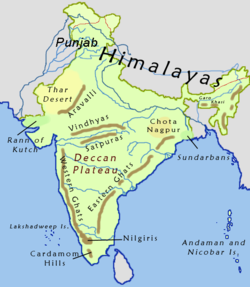K/T extinction event

The Cretaceous–Tertiary extinction event, now called the Cretaceous–Palaeogene extinction event,[1] was about 65.5 million years ago.[2] It may be called the K/T extinction event or K/Pg event for short. This is the famous event which killed the dinosaurs at the end of the Cretaceous period.
It was a large-scale mass extinction of animal and plant species. The event marks the end of the Mesozoic era and the beginning of the Cainozoic era.[3][4]
Effects
Dinosaur fossils are only found below the K/T boundary. This shows they became extinct before, or during the event.[5] Mosasaurs, plesiosaurs, pterosaurs and many species of plants and invertebrates also became extinct.
Mammalian and bird groups got through the event with some extinctions. Those that survived became widespread and varied during their later evolutionary radiation.[6]
Causes
The K/T extinctions were so sudden and far-reaching that they must have been caused by something sudden and powerful. One or more massive asteroid or meteor impacts, and increased volcanic activity have been suggested.
How quickly animals died out around the world is an important clue.[5] Patterns in rocks also suggest causes. There are several impact craters and massive volcanic activity in the Deccan Traps in India dated to about the same time as the extinctions. Those impacts and volcanoes would have reduced sunlight and hindered photosynthesis, disrupting Earth's ecology.[6]
The best supported theory is that the meteorite strike in the Yucatan was the main cause of the extinction at the end of the Mesozoic era.[7]
Craters
There were several impact events across the Cretaceous/Tertiary boundary, such as the Chicxulub crater in Mexico, Boltysh crater in Ukraine, Silverpit crater in North Sea, and the Shiva crater offshore western India.[8][9] The Shiva crater is a sea floor structure under the continental shelf in the Indian Ocean, west of Mumbai, India. It was named by paleontologist Sankar Chatterjee after Shiva, the Hindu god of destruction and renewal.
Related pages
References
- ↑ Because the term "Tertiary" is out of date.
- ↑ Renne, Paul R.; Deino, Alan L.; Hilgen, Frederik J.; Kuiper, Klaudia F.; Mark, Darren F.; Mitchell, William S.; Morgan, Leah E.; Mundil, Roland; Smit, Jan (2013). "Time scales of critical events around the Cretaceous-Paleogene boundary" (PDF). Science. 339 (6120): 684–687. Bibcode:2013Sci...339..684R. doi:10.1126/science.1230492. PMID 23393261.
- ↑ Fortey R (1999). Life: A natural history of the first four billion years of life on Earth. Vintage. pp. 238–260.
- ↑ With "Tertiary" being discouraged as a formal time or rock unit by the International Commission on Stratigraphy, the K/T event is now called the Cretaceous–Palaeogene extinction event by many researchers. Gradstein F, Ogg J, Smith A. A geologic time scale 2004.
{{cite book}}: CS1 maint: multiple names: authors list (link) - ↑ 5.0 5.1 Fastovsky, David E.; Sheehan, Peter M. (March 2005). "The Extinction of the Dinosaurs in North America" (PDF). GSA Today. 15 (3): 4–10. Retrieved 2017-04-22.
- ↑ 6.0 6.1 MacLeod N.; et al. (1997). "The Cretaceous–Tertiary biotic transition". Journal of the Geological Society. 154 (2): 265–292. doi:10.1144/gsjgs.154.2.0265.
- ↑ Schulte, Peter & others 2010. The Chicxulub asteroid impact and mass extinction at the Cretaceous–Paleogene Boundary. Science 327 (5970): 1214–1218. [1]
- ↑ Chatterjee, Sankar et al 2003. Paper No. 60-8, Seattle Annual Meeting of Geological Society of America. The Shiva Crater: implications for Deccan volcanism, India-seychelles rifting, dinosaur extinction, and petroleum entrapment at the K/T boundary.
- ↑ Mullen, Leslie 2004. Astrobiology Magazine.Deep impact -- Shiva: another K-T impact?

